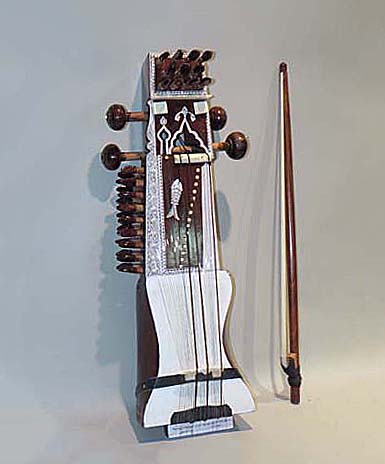
Owner: HWMC
Catalogue #: 2AS-CHLT-34-16
Lutes
India 'Sarangi' (Hindustani)
India
Hindustani
Wood, metal strings, gut strings, leather, hide, bone
Late 20th century
Length: 27 in, Width: 8.5 in, Depth: 5.25 in
Chordophones – Lutes
This is a sarangi, a short-necked bowed fiddle of South Asia used in Hindustani classical raga music of North India and in folk music. It is closely related to the Sarinda, also found in this collection. This sarangi belongs to the Hindustani classical subgroup of the sarangi. It is handmade from a single block of tun wood in a rectangular slightly waisted body shape. The main parts include, the pegbox at the top, the unfretted neck, the body, and the string holder at the bottom. The hollow body is covered with goat skin. This sarangi has the three melody gut strings, tuned a fifth and fourth apart, and a bass sympathetic string. There are 24 metal sympathetic strings that feed through the circular bone bridges (sundari) on the face of the neck to the pegs located in the box behind the neck. A second group of eleven sympathetic strings are attached to the top box of pegs. Four bone bridges are used to hold the strings up and away from the neck and skin belly. All the strings are fastened to the tailpiece called the targahan.
The sarangi has the range of approximately 32 notes, the range of the human voice. It is played while sitting and is held against the left shoulder in a vertical position. The musician uses a bow held in an underhand grip in his right hand, while the fingernails of the left hand pressed against the strings to stop and shorten the vibrating length of the main strings to produced various pitches.
